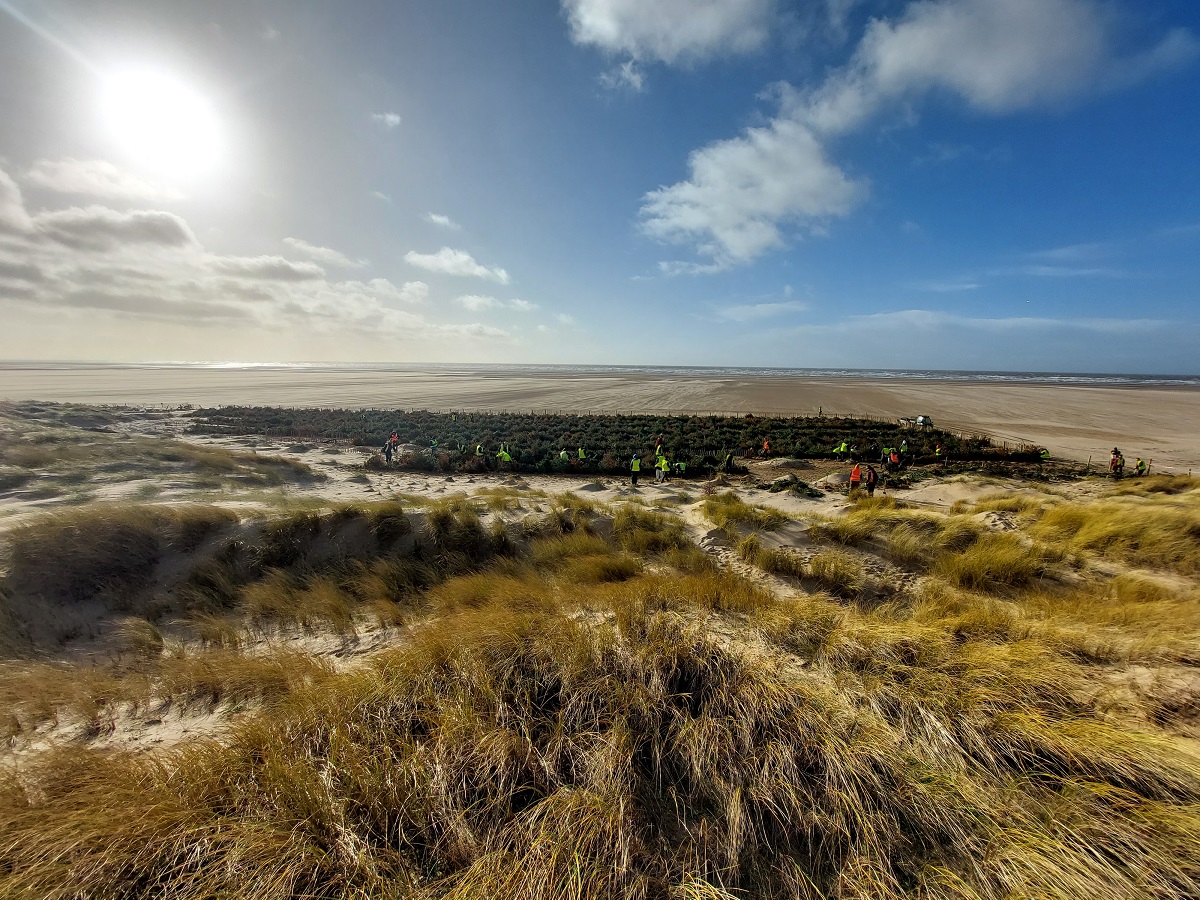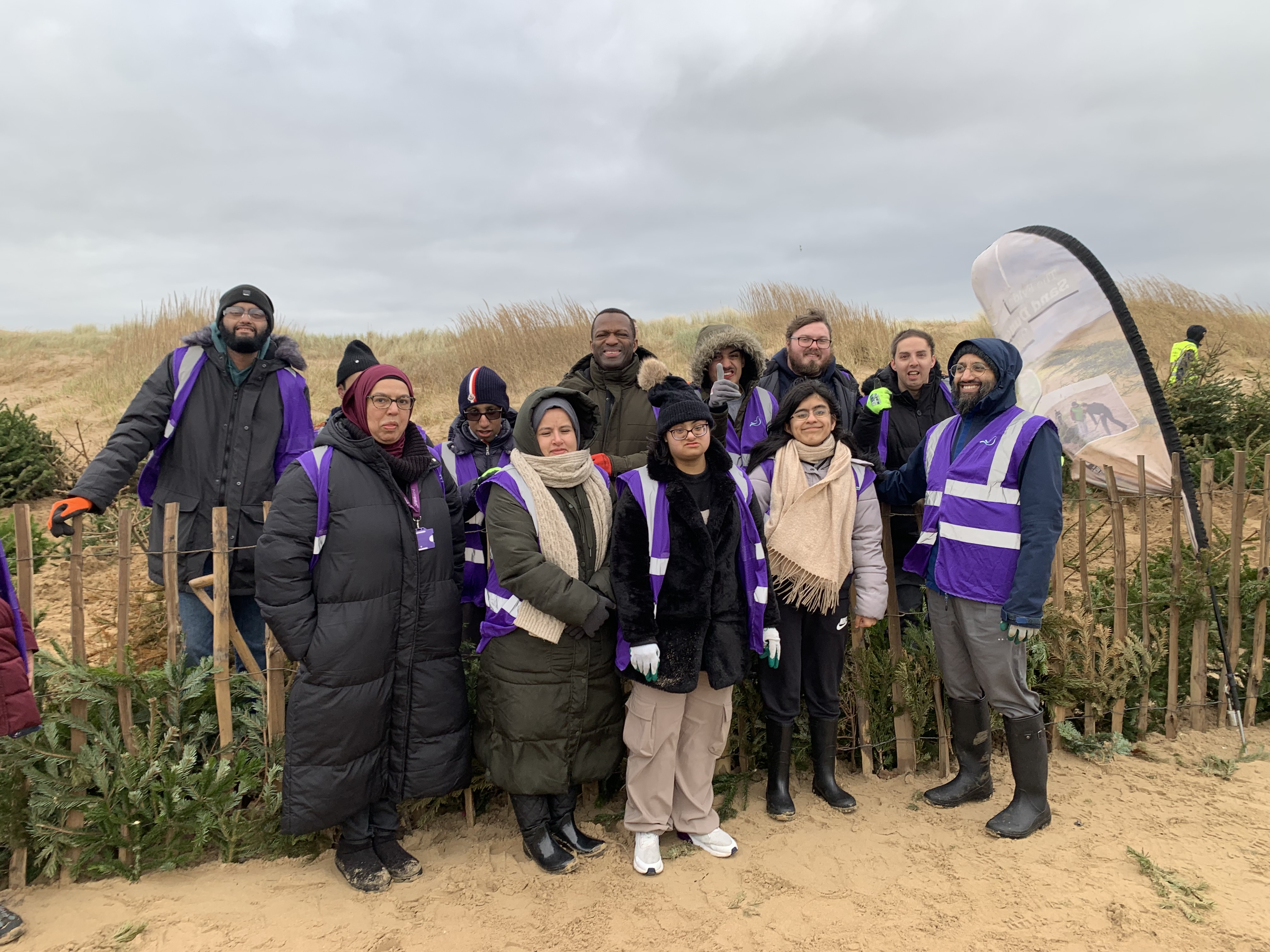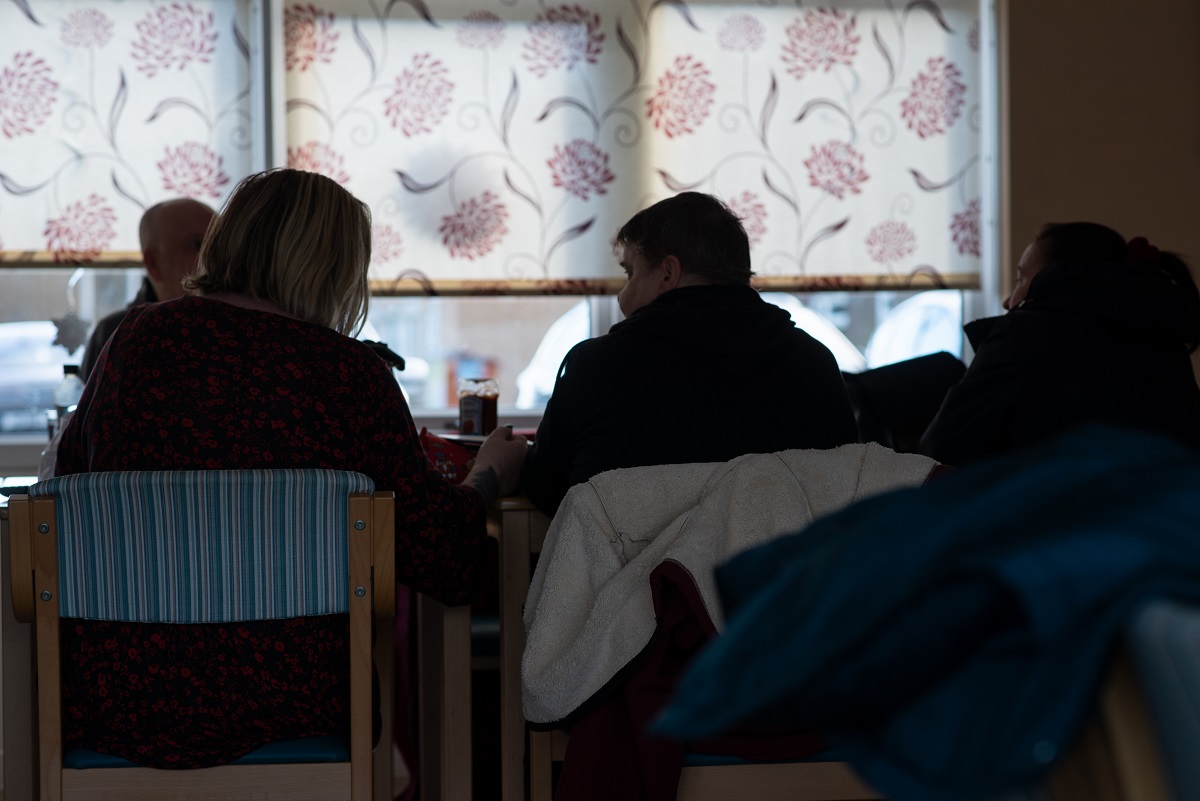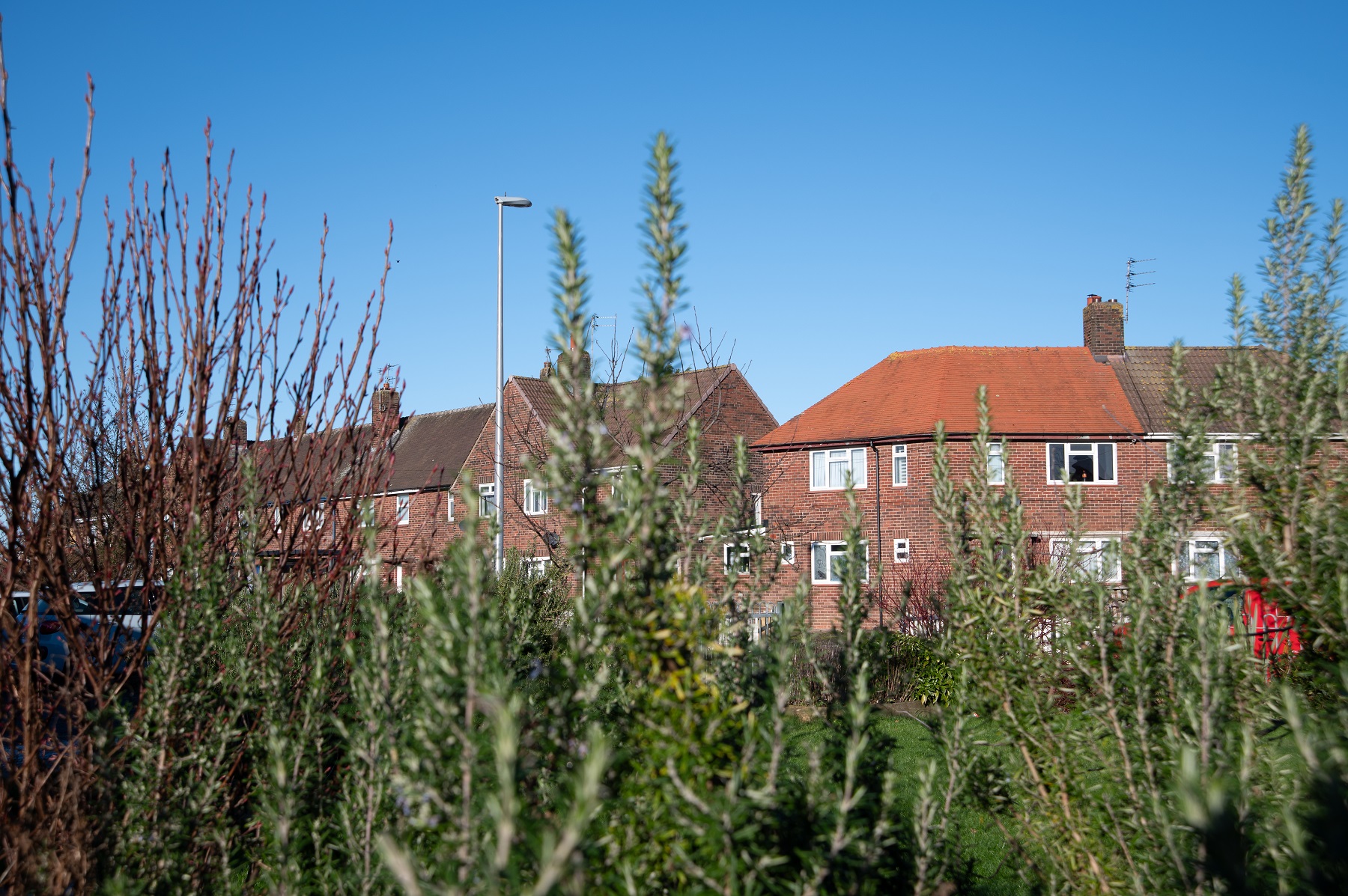Hundreds of volunteers fighting to save the Fylde Coast's sand dunes
Sand Dunes are increasingly rare in the UK and ours represent 90 per cent of those in Lancashire. Christmas trees - and hundreds of volunteers - form a vital part of the strategy to keep them alive
Three thousand Christmas trees are piled up on North Beach car park in St Annes but Amy Pennington is worried it’s still not enough.
“We’ve become a victim of our own success really,” she says to The Blackpool Lead, talking of the Fylde Sand Dunes Project’s annual Christmas tree planting. “It’s a real balancing act. You never want more volunteers than there are trees to go around. This year I was worried so I put out a plea for more Christmas trees which seemed to work.”
Despite harsh winds, some 260 volunteers have shown up today and Pennington, community engagement officer for the Fylde Sand Dunes Project, is closely guarding 50 per cent of her stock for the further 300 who are expected tomorrow. Their mission – to dig ditches in the sand and plant the trees that were discarded by households across the Fylde Coast and Preston at the end of the festive period.
“It started off as a tiny operation with about 500 trees in 2013 and it was just staff who put them in with a couple of regular volunteers,” she says. “Since then it’s just grown and grown.”
Growth is the vision for the sand dunes themselves. A natural feature of the Fylde Coast’s landscape, the grass covered dunes stretch over 80 hectares from where Blackpool’s promenade ends at south shore, through St Annes, to Lytham.
Sand Dunes are increasingly rare in the UK and ours represent 90 per cent of those in Lancashire. Not only are they important for recreation and enjoyment – they’re a unique habitat for wildlife and act as a soft sea defence for coastal towns.
But over the past 150 years the Fylde Coast has lost around 80 per cent of its sand dunes.
“It’s not due to coastal erosion,” Pennington explains. “It’s because of the building and infrastructure of the towns. The dunes would have once extended miles and miles inland before the towns were developed.”
Sand dunes are not a fixed feature of the landscape and naturally shift and change, explains Ed Mooney, from Fylde Ranger services. He’s hidden among the network of existing dunes directing volunteers as they thatch Christmas trees in a ‘blowout'.
“Blowouts are areas of bare sand where dunes have been blown away by high winds,” he says, as volunteers drag trees behind them over the sand.
“Sand dune systems tend to move one way or another – they’re either eroding or accreting. In Southport they are eroding so they maintain theirs slightly differently. Accretion means sand is blowing onto them. In winter they are carved up by storms and then in summer embryo dunes start to form.”
Over the past 150 years the Fylde Coast has lost around 80 per cent of its sand dunes.
“It’s a millennia-long process so eventually they will be eroding and then they’ll be accreting again. Fylde is quite unique because it has very long flat sands, so the dunes are not cornered in. It’s a really special landscape for that reason but they are exposed.”
Marcus Frew is attempting to direct 14 of his year nine geography students from Montgomery High School in the blowout. Using shovels, they bore holes two or three feet deep in neat rows across the bare patch before dropping their trees into them at a 45 degree angle towards the sea, and packing them down with sand. Now, when wind blows the sand in their direction, it will be get caught among the branches. Eventually they’ll be covered and form new dunes.
“We’ve been learning about soft engineering – ways of protecting the coastline from flooding and erosion, but that blends in with the natural environment,” he tells The Blackpool Lead. “So it’s not a big sea wall or anything, it’s interventions you can do to work with nature to protect the coast.”
But Frew says you can look at the theory in the class “all you want” but it isn’t until you actually get out in the field that you really understand it.
“Especially on such a windy day you understand how strong the forces of nature are. And also the necessity of it because you can see the communities on the other side of the sand dunes and people coming together to try and defend them from flooding.”
Lancashire Wildlife Trust Fylde Dunes Officer Amy Pennigton
One of his students, Ava, is making good progress, even while giggling with her friends. While geography is her favourite subject at school she says today beats any day in the classroom, before promptly falling into the hole she’s digging and falling about laughing.
“Geography is a really dynamic subject in high schools now,” Frew says. “I think it’s just a lot more up to date and a lot more relevant to them as children who, from primary school, are aware of climate change. These are big global issues that will be particularly prevalent in their lifetimes so it gives them a bit of hope as well, because there are solutions to the problems.”
Frew says he’s proud of the kids for working so hard and they’re all enjoying it. When they visit the sand dunes he hopes they will feel pride too, in playing their part in protecting them.
“These are big global issues that will be particularly prevalent in their lifetimes”
“It empowers them to realise that everybody does have a voice and the more knowledgable you are about these issues the better you can make choices for yourself, your school and your community.”
This kind of outreach and education is important to Pennington who, along with volunteers, runs regular beach schools on the dunes in fairer weather, with activities including mini beast hunting and mud dipping, while teaching young people about practical conservation. For some local children, she says, it’s the first time they have ever been to the beach and she hopes to instil an affinity to the coastline in them, as well as a need to protect it.
Back on the foreshore, grateful volunteers queue up for hot drinks and biscuits in a pop-up gazebo that blows precariously in 40 mph gusts of wind. Beyond it is a network of sand dunes that back onto the car park but photographs displayed show the landscape in 2005 when this area was a blowout.
Sand lizards on the Fylde Coast
“These dunes are about five or six metres high now but the width is the important bit,” says Pennington. Naturally, new dunes would form inland but the physical barrier of Clifton Drive beyond them, and the sprawling town beyond that, means they have to reverse the process.
In front of this strip of dunes a long stretch of trees is being planted by an army of volunteers in a ditch made in advance by a mechanical digger. Once this row of trees is covered by blown-in sand the stretch will be even wider.
“We’ll keep drawing the dunes out, bringing them forward towards the sea by about 10 metres a year, until we reach the mean high watermark – where the tide averages about nine metres – then we’ll concentrate on building them up.”
The Christmas tree planting is great, she says, because it mobilises the community and they are free. Each January locals can drop off their discarded trees at allocated points or they can be collected by charities including Trinity Hospice for a nominal donation.
“Our Christmas tree is somewhere in this mess,” says Kate Barnes who, like many volunteers here today, has come with work as companies across Lancashire exercise their corporate social responsibility (CSR). She’s the CSR lead for ESG, a Chorley-based IT consultancy.
“We were looking for opportunities to give back to the local community and help improve the environment we live in. We did this for the first time as a team last year and it was a huge success. I think we had about 20 people last year and the same this year.
“It’s hard work but it’s a brilliant day. Last year we had beautiful weather. When we were finishing at about four o’clock, and the sun was going down, we didn’t want to leave. But even today it’s fine and it beats going to the gym.”
But the work expanding the dunes doesn’t stop after this annual event. Pennington points to a low dune at the front of the existing system where a neat row of narrow logs pokes out from the top.
“This is chestnut pailing fencing underneath here and that row there has been buried,” she says. “The fencing acts in the same way as the Christmas trees but we can do it throughout the year. It’s porous so it allows the sand to travel through the same as the branches of the Christmas trees, but it slows the wind velocity enough that the sand is deposited in and around it.

Planting Christmas trees on the Fylde Coast
“It works really well but it’s very expensive and since Covid we’ve noticed a 300 per cent mark-up.”
Whatever they put in, the Sand Dunes Project, which is run by Lancashire Wildlife Trust and funded by the Environment Agency, has to make sure it won’t regrow. Another big part of what staff and volunteers do year-round is taking out invasive plant species. Since the project began in 2008, it’s removed 40 per cent of the non-native plants on the dunes and the neighbouring nature reserve, on the other side of Clifton Drive, including sea buckthorn, white poplar, Japanese rose and Japanese knotweed.
The dunes host 280 vascular plant species, including dune helleborine and Isle of Man cabbage, which now have room to thrive. They are part of the reason why parts of the dunes have been designated a Site of Special Scientific Interest – an area that represents our natural heritage.
“Once sand has been blown away from the dunes system it’s classed as contaminated and can’t be put back in. Once it’s lost it’s lost.”
Most visible are the dune grasses – around 50 per cent of which are naturally occurring. The other 50 per cent are planted by the Sand Dunes Project.
“We buy plug plants in and then we take them to Ashton Gardens in St Annes and grow them on before planting,” says Pennington. “We put about 3-4000 in a year. Once these new dunes are all built up we’ll then plant on them.
“We plant the shorter lyme grass but the longer grasses are marram grass, which is particularly useful because it has really long, wide roots that bind all the sand particles together, helping us harness it before it blows away. Once sand has been blown away from the dunes system it’s classed as contaminated and can’t be put back in. Once it’s lost it’s lost.”
Unsurprisingly the rich flora that grows on the dunes supports a wealth of wildlife too. They are home to 100 butterfly and moth species as well as breeding birds like stonechats and skylarks. They are also frequented by kestrels, sparrow hawks and occasional barn owls. The team has also dug out a series of dune slacks – wet areas where special plants like orchids can be found and that provide a perfect habitat for amphibians like frogs and toads.
The most welcome of all species on the sand dunes, perhaps, is sand lizards. The Sand Dunes Project released more than 400 of them over four consecutive Septembers from 2017.
“Sand lizards used to be here. There are unconfirmed reports of them in the ‘60s but there are no official records,” says Pennington. “They were lost along with 80 per cent of the dunes but they are a great habitat for them.”
In Sefton, however, 3 per cent of a native population of sand lizards remained, and two captive breeding centres were working to grow it. The centres have outdoor enclosures that mimic the natural dune environment, where the lizards could be suitably prepared for release.
“A lot of research into it was done and we had to get the Zoological Society of London up to assess it,” says Pennington. “Then we did a lot of work to get the habitat exactly right, creating sand patches because they like to bask on the bear sand.”

Volunteers from Purple Patch
Pennington glows with pride as she reports that the population on the Fylde Coast is now “doing really well”.
“We’ve seen eggshells, so we know they’re breeding, and one brave female has even made it north across Clifton Drive and onto the nature reserve. Now we know they can make it across, we can look at the reserve and do some management on there to make it a more effective habitat for them.”
But she says it’s very unlikely members of the public will spot them, and warns against looking.
“They’re a protected species so you need a licence to be able to look for them. We have lots of volunteers who have signed up to go out and survey them but we don’t want them to be disturbed by the general public. They’re also very hard to find. You have to go out in the right conditions, at the right time, and on your own when it’s quiet, so the chances of seeing them is very slim.”
“I’m proud that the dunes are here because of me. We’re looking after them,”
As midafternoon approaches Pennington says that the 50 per cent of trees allocated for planting today have almost gone. She’s considering using a few more from tomorrow’s stock because rain is forecast and she’s not sure the turn out will be as good. Navigating the elements like this is a key part of her job. Usually the planting happens over three days but this year tide times have restricted it to two.
Still hard at work are volunteers from Blackburn-based Purple Patch – a non-profit organisation addressing the unmet needs of disabled people, in particular those from an ethnic minority heritage.
“I’m proud that the dunes are here because of me. We’re looking after them,” says Shakil Ahmed, one adult service user. “Me and my friends have helped to make it a nicer and safer place for the wildlife and the environment. We come here for walks sometimes, and picnics, even though we’re from Blackburn, so it’s nice to look after them.”
Staff member Rafik Jasad, who’s brought the group today, tells Ahmed he should be very proud.
“We’re trying to get our group connected to nature, connected to wildlife, connected to the natural world and to try and learn about important environmental issues,” he says.
“A lot of our guys find it very difficult to come out on their own and need one-to-one support. That means that a lot of the time it’s difficult, especially for families because they have other children to look after. When they come to us we try and ensure they get the opportunity to get out and experience the outdoors.
“Absolutely every one of us loves it,” adds Jasad. “The fresh sea air, and what that does for you physiologically and psychologically, is very therapeutic.”
To volunteer with the Fylde Sand Dunes Project or to find out about upcoming events, visit their website.
You can see the previous newsletter we sent to our subscribers here
The Blackpool Lead is now on Substack.
Become a Member, and get our most groundbreaking content first. Become a Founder, and join the newsroom’s internal conversation - meet the writers, the editors and more.





